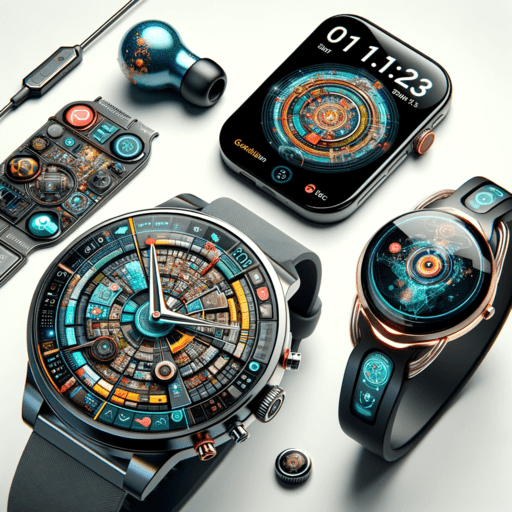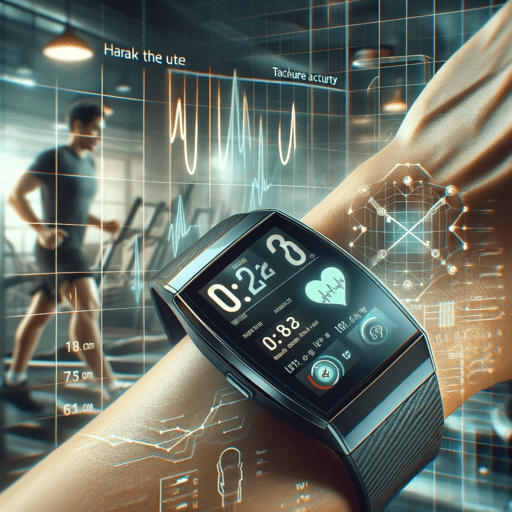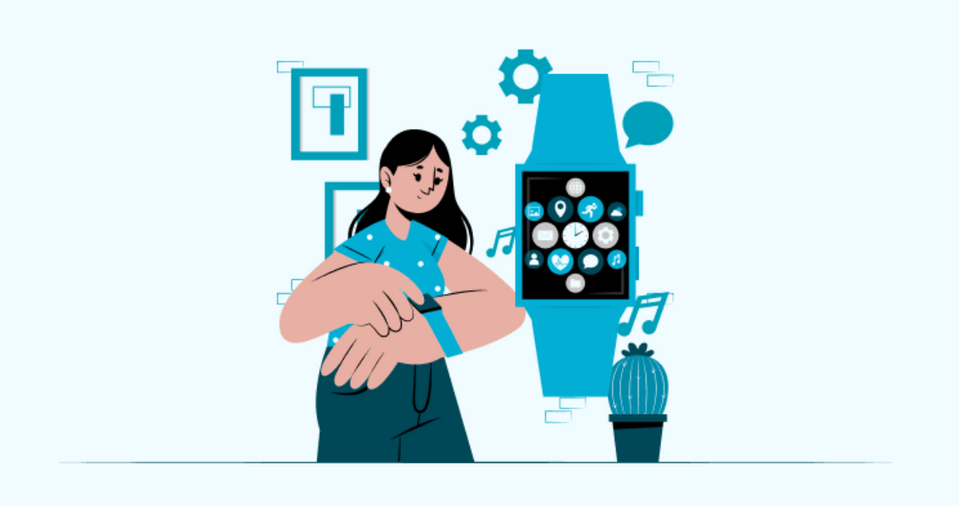Whether in the gym sweating out for that perfect workout or a swim in the evening, one gadget always with you is a wearable like a smartwatch. Similarly, there are several wearables that people worldwide use, including fitness trackers, smartwatches, fashionable wearable accessories, and AR/VR headsets.
Such popularity of wearables has been pivotal for the market to grow at 17.6% of CAGR and is expected to reach $419.44 million by 2028. One of the critical reasons why wearables are popular is the ease of accessing insights.
For example, if you are working out, the ease with which you can record data and sync with devices like smartphones is crucial. Providing such capabilities requires strategic wearable device design considerations and a user-friendly interface.
Further, there are several wearable technology challenges that you need to overcome before developing your product. This article will focus on specific challenges in wearable design and development.
Wearable Technology Design Landscape
Wearable technology design has evolved over the years with the advent of innovative features and functionalities. Take the example of the most popular category of the wearable market- smartwatches.
In the early days, smartwatch designs and development were primitive, with limited functionalities. It is mainly known as fitness trackers, though it currently forms an entire category of wearables.
What has changed is the integration of advanced sensors. Most wearable technology devices depend on multiple sensors to record, analyze, and process data. Integrating the sensors, syncing the data, and representing them on your apps require an intuitive interface. This is where significant challenges are for any wearable design and development.
Increasing focus on gesture-based technology and innovations is already pushing the boundaries beyond general-purpose use cases. For example, Apple’s Vision Pro brings a new set of gesture-based user experiences that combines excellent design and innovative capabilities.
Adding such functionalities based on use cases can be challenging, and designing your wearables accordingly becomes complex. There are other challenges and opportunities to consider while designing the wearables for your business.
Challenges in Wearable Design and Development
Wearables have become more functional with new features like Bluetooth calling, gaming, and live location tracking. These devices can do everything from monitoring the heart rate to measuring blood oxygen and even monitoring glucose levels in the bloodstream.
However, companies must overcome wearable design challenges to improve the user experience. The first and most debatable is space restrictions!
1. Smaller space, bigger functions
Wearable device design considerations vary based on what type of function you want to add. If you are developing a smartwatch that can show maps on the go, fitting the entire map layout on a 1.4-1.79-inch screen can be a significant challenge.
Considering the screen size is insufficient, you must also consider the accessibility of crucial features icons on the user interface. Further, you must design the wearable devices to avoid accidental touches affecting the user experience.
On the hardware side, you can get creative, but UX designers also need to consider the software side of the wearable designs. This is where designers and developers can implement the KISS(Keep It Simple, Stupid) design principle. It lets you declutter the user interface and enhance the wearable experience.
2. Responsive touches and speed
Responsiveness of any wearable device is crucial because, in a competitive market, high latency user interface can impact the user experience. For example, if the latency of touch controls on your earbuds is higher, the experience of listening to a song on your smartphone is hampered. Similarly, a lag between your workout tracker while you are sweating it out in the gym affects your wearable experience.
So, wearable device interfaces and hardware must be highly responsive to each gesture and ensure maximum accessibility. However, ensuring responsive UI for your wearable is a significant challenge. The interface has multiple elements, and you must consider several aspects before designing a wearable.
While you create user interface design for wearables, ensure low latency performance through the following tips:
- Design the wearable user interfaces according to different screen sizes. This will enhance the experience of your wearable UI across devices, ensuring a uniform experience.
- Keep the navigation between two interaction steps simple. This will ensure minimal travel between two endpoints while the user takes a specific action.
- Ensure lightweight UI design elements to maximize functionality and responsiveness across UI
- Use natively compatible fonts to provide a better experience, leveraging platform-specific capabilities for your wearables.
3. Visual design and accessibility

Wearables are not just about functionalities and need aesthetics to improve customer traction. However, maintaining the visual design aesthetics and functionality together is challenging for most wearable designers.
Designing stylish wearables with intuitive UI needs a design thinking approach. You need to find opportunities in wearable UX to enhance design aspects. For example, a smart ring can display body temperature through a tiny screen on its hardware.
However, it can impact the aesthetics of the smart ring. The best way to design such a product is to keep the data visibility on a smartphone app, keeping the smart ring aesthetically pleasing.
4. Uniform UX across platforms
If you are designing a wearable application, consider multiple platform requirements. Take an example of a smartphone wearable application. Your app must run seamlessly across platforms, whether it's Android or iOS. This becomes challenging because you must design the wearable application according to native environment guidelines.
Integrating native features and gesture-based functions in your wearable application requires custom APIs. So, API compatibility, platform specifications, and native capabilities are key considerations for your wearable app development. Here is how you can overcome these challenges:
- Develop a cross-platform application for your wearable project.
- Ensure uniformity across wearable and mobile apps needed to sync data
- Make sure you leverage native capabilities and configure the app according to the native environment
- Customize APIs to ensure secure communication between the application and external services.
5. Limited attention span
Customers have a limited attention span with increasing internet usage and more access to content. At the same time, ensuring a user experience fits into a customer's normal attention span range.
The average attention span for any customer is 8 seconds, and designing your wearables to ensure the content is scannable becomes important. Also, if you are designing for small screens in wearables, font size, and typography need to be optimal, which can improve visibility with limited attention spans.
6. Immersion and Intuitiveness
Immersive design is essential to using augmented reality in wearables. So, how do you ensure an immersive experience for your AR/VR wearables? Apart from the gesture-based feature of Apple’s Vision Pro, you must focus on UI.
Using these wearable technology UI best practices can help improve the AR/VR experience.
- Leverage wearable device interaction design by integrating gesture controls, voice commands, and touch responses
- Immersive design for the AR/VR wearables needs user experience considerations like motion sickness.
- Ensure fonts, contrasts, and audio cues are integrated into the design to provide an immersive experience.
- Perform A/B testing for AR/VR wearable UI designs
7. Tracking feature accuracy

Before you design health and fitness wearable UX, one key consideration to keep in mind is data accuracy. Most fitness trackers make sure that the health data is accurate and secure. However, maintaining health data security and ensuring that sensors measure precise data of each activity is one of the major wearable technology challenges.
If you want to achieve such accuracy, there needs to be a synergy between the physical and UI design of the wearable. You need to analyze the entire design layout and find key opportunities for improvements in wearable UX.
For example, a Reddit post from a user showcased how fitness tracking from a leading brand's wearable was inaccurate. After spending almost 30 minutes on an elliptical machine, the wearable device could not detect any health data. So, if you are developing a fitness tracker, accuracy and data sync are essential** **wearable device design considerations.
8. Designing a secure device is crucial
Maintaining data privacy for your wearables is essential for improved user trust and ensuring compliance with data regulations like HIPAA and GDPR. For example, wearables constantly track and record the users' geolocation data.
If you don’t have wearable technology privacy design in place, it can lead to data leakages. The geolocation data of users is personally identifiable and needs protection. So, there is no denying that you need to develop wearables with higher data privacy and security.
Here are some tips to follow:
- Create a transparent data collection policy for your wearables and communicate with customers.
- Provide an option for users to opt out of data sharing in your wearable application
- Use end-to-end encryptions to ensure there is no unauthorized access to wearable data.
- Provide granular control options for users to choose specific services to access their geolocation data.
- Anonymize geolocation data before sharing it with external third-party services.
- Ensure regular security patches are updated regularly to ensure protection against cyberattacks.
9. Context-aware design for wearables
Wearable design that adapts based on the changing environment and activities of a customer is often known as context-aware design. Creating seamless transitions across contexts and improving the user experience poses a unique challenge.
You can combine different elements of wearables like sensors, user interface design, and features to create a context-aware design. For example, you can create an instant notification feature that sends timely notifications on wearables according to user location changes.
This includes adjusting the user interface dynamically according to the changing environment of users and leveraging sensors and real-time data. It allows you to improve personalization in wearables and create an enhanced user experience.
10. Designing for better battery life
Wearables are smaller and fitting a larger battery in it is next to impossible. However, you can optimize the battery life of wearables through optimization on a software level. You must also identify critical features and functionalities that can drain the wearable battery quickly.
For example, using an AMOLED screen for wearable devices can drain the battery more, but if you reduce features like an always-on display. It can help optimize power for wearables, ensuring longer battery life.
Key takeaways
As wearable technology evolves, there are new challenges for designers and developers to overcome. This is where wearable UI best practices come into play. However, each challenge presents a unique opportunity for you to design wearables for better accessibility, experience, and seamless functionality.
The most significant aspect to remember for all your wearable device design considerations is simplicity. How simple, intuitive and immersive your wearable app will impact the entire usage experience. As you can observe above, there are several challenges and best practices discussed, leverage them to enhance your wearable design.
Author
Kunal Vaja, founder of Zennaxx, a software and an app development company. He is actively involved in community initiatives, mentorship programs, and industry events, sharing insights and expertise to inspire the next generation of tech innovators.




